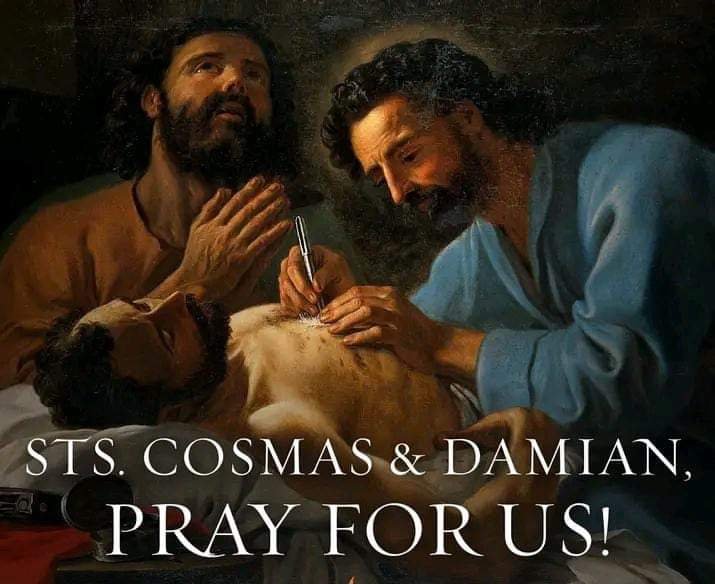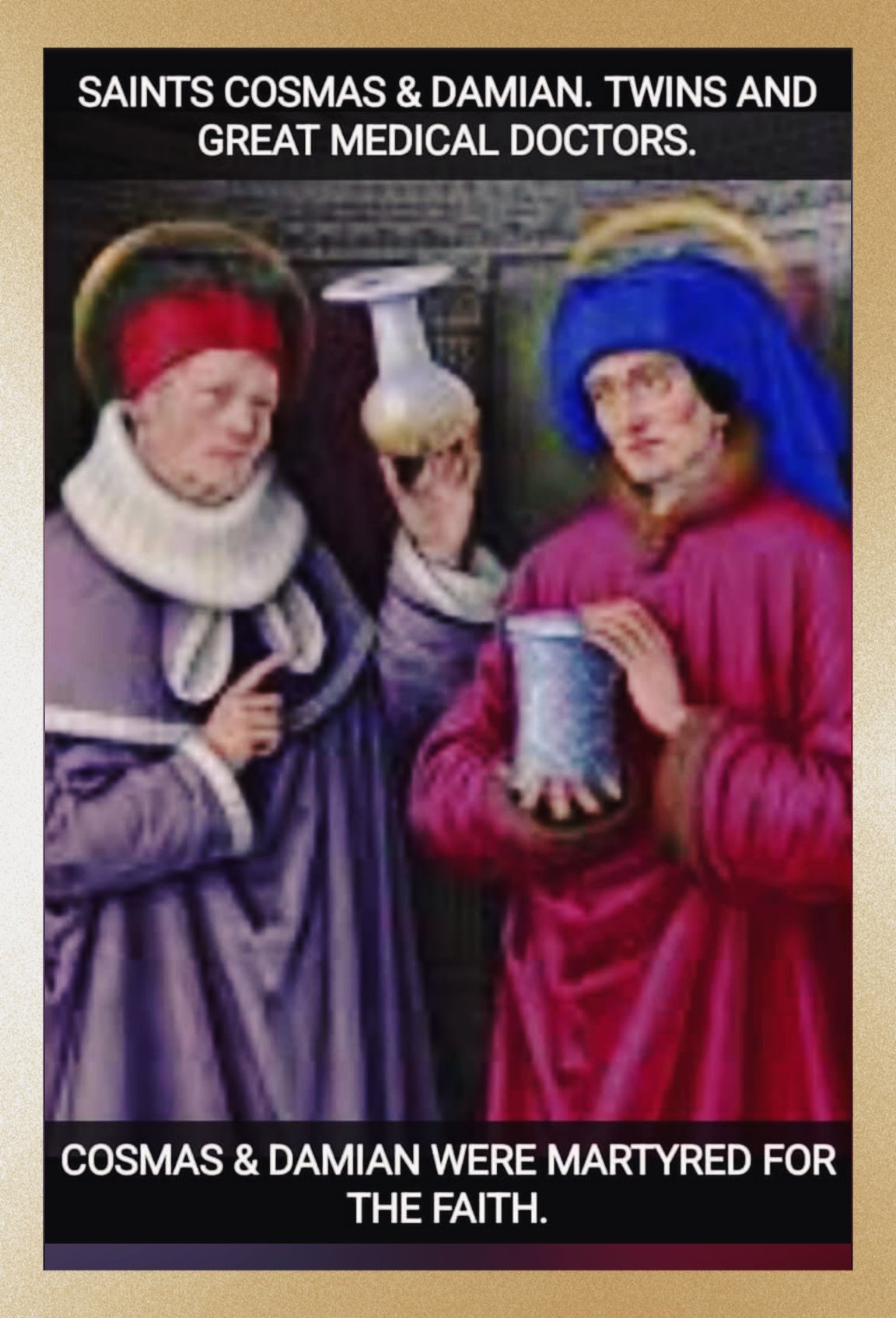FEAST OF SAINTS COSMAS AND DAMIAN, MARTYRS
FEAST DAY – 26th SEPTEMBER
Cosmas and Damian (c. 3rd century – c. 287 or 303) were two Arab physicians in the town Cyrrhus, and were reputedly twin brothers, and early Christian martyrs. They practised their profession in the seaport of Aegeae, then in the Roman province of Syria. Cosmas and Damian embraced Christianity and practised medicine and surgery without a fee. This led them to be known as the holy unmercenaries, the Anargyroi (without silver).
They reputedly cured blindness, fever, paralysis and reportedly expelled a breast serpent. They were arrested by Lysias, governor of Cilicia (modern day Çukurova, Turkey) during the Diocletian persecution because of their faith and fame as healers. Emperor Diocletian was a religious fanatic and favoured the pantheism of the Olympian Gods. He issued a series of edicts that condemned the Christians in his attempt to wipe out Christianity from his empire.
Accepting no payment for their services led to them being named anargyroi (from the Greek Ἀνάργυροι, ‘the silverless’ or ‘unmercenaries’); by this, they attracted many to the Christian faith. Nothing is known of their lives except that they suffered martyrdom in Syria during the persecution of the Emperor Diocletian. According to Christian traditions, the twin brothers were born in Arabia and became skilled doctors.

Saladino d’Ascoli, a 15th century Italian physician, claims that the medieval electuary, a pasty mass consisting of a drug mixed with sugar and water or honey suitable for oral administration, known as opopira, a complex compound medicine used to treat diverse maladies including paralysis, was invented by Cosmas and Damian.
During the persecution under Diocletian, Cosmas and Damian were arrested by order of the Prefect of Cilicia, one Lysias who is otherwise unknown, who ordered them under torture to recant. However, according to legend they stayed true to their faith, enduring being hung on a cross, stoned and shot by arrows and finally suffered execution by beheading. Anthimus, Leontius and Euprepius, their younger brothers, who were inseparable from them throughout life, shared in their martyrdom.
The veneration of Cosmas and Damian quickly spread beyond Constantinople; accounts of their martyrdom were rewritten by various authors such as Andrew of Crete, Peter of Argos, Theodore II Laskaris, and a certain Maximus around 1300. The legends are preserved also in Syriac, Coptic, Georgian, Armenian, and Latin.

As early as the 4th century, churches dedicated to the twin saints were established at Jerusalem, in Egypt and in Mesopotamia. Devotion to the two saints spread rapidly in both East and West. Theodoret records the division of their reputed relics. Their relics, deemed miraculous, were buried in the city of Cyrrus in Syria. They are patron saints of pharmacists, physicians, and surgeons.
Churches were built in their honor by Archbishop Proclus and by Emperor Justinian I (527–565), who sumptuously restored the city of Cyrus and dedicated it to the twins, but brought their purported relics to Constantinople; there, following his cure, ascribed to the intercession of Cosmas and Damian, Justinian, in gratitude also built and adorned their church at Constantinople, and it became a celebrated place of pilgrimage.

At Rome Pope Felix IV (526–530) rededicated the Library of Peace (Bibliotheca Pacis) as a basilica of Santi Cosma e Damiano in the Forum of Vespasian in their honour. The church is much rebuilt but still famed for its sixth-century mosaics illustrating the saints. What are said to be their skulls are venerated in the convent of the Clares in Madrid, where they have been since 1581, the gift of Maria, daughter of Emperor Charles V.
They had previously been removed from Rome to Bremen in the tenth century, and thence to Bamberg. Other skulls said to be theirs were discovered in 1334 by Burchard Grelle, Archbishop of Bremen. He “personally ‘miraculously’ retrieved the relics of the holy physicians Cosmas and Damian, which were allegedly immured and forgotten in the choir of the Bremen Cathedral. In celebration of the retrieval Archbishop and Chapter arranged a feast at Pentecost 1335, when the relics were translated to a more dignified place.

Grelle claimed the relics were those Archbishop Adaldag brought from Rome in 965. The cathedral master-builder Johann Hemeling made a shrine for the relics, which was finished around 1420. The shrine, made from carved oak wood covered with gilt and rolled silver is considered an important mediaeval gold work. In 1649 Bremen’s Chapter, Lutheran by this time, sold the shrine without the heads to Maximilian I of Bavaria. The two heads remained in Bremen and came into the possession of the small Roman Catholic community.
They were shown from 1934 to 1968 in the Church of St. Johann and in 1994 they were buried in the crypt. The shrine is now shown in the Jesuit church of St Michael in Munich. At least since 1413 another supposed pair of skulls of the saints has been stored in St Stephens’s Cathedral in Vienna. Other relics are claimed by the Church of San Giorgio Maggiore in Venice.

PRAYER
O Lord, we magnify your Holy Name by venerating the memory of your Saints Cosmas and Damian, for with your Divine Providence, you have uplifted them to an everlasting glory, and on us, you have bestowed your unfailing help.
Saints Cosmas and Damian, twins who became excellent doctors, refused payment for their medical care because they believed that when they treated patients, they were also caring for Jesus. By conveying great love, they won the hearts of their patients as they taught them about the Faith. May we follow their example in our lives.
Through our Lord Jesus Christ, your Son, who lives and reigns with you in the unity of the Holy Spirit, God, for ever and ever. Amen

Saint Cosmas and Damain, Pray for us!






